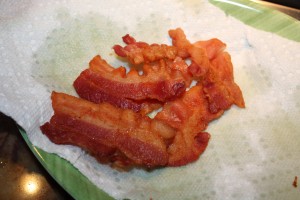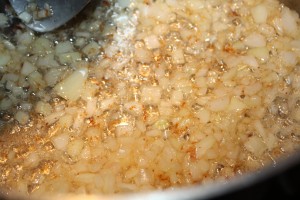Creating new meals with leftovers is one of my specialties. I simply don’t like to throw away food. Tonight’s leftovers can turn into tomorrow’s delicacy. All you need is a little creativity. According to the U. S. Department of Agriculture, Americans discard nearly 100 billion pounds of food every year. That translates into $600 of wasted food (on average) per 4 person household each year, resulting in great cultural, economic and environmental repercussions. There are not only increasing costs of energy to produce food and transportation, but also in the ways the leftovers are disposed. Considering the fact that food that rots under anaerobic (without oxygen) conditions releases methane (a greenhouse gas that is approximately 20 times more potent than carbon dioxide) into our atmosphere and that the carrot you threw away last week could take about 40 years to disappear in the landfill, we should face the fact that, sooner or later, we have to incorporate into our lifestyle ways to be more creative and responsible in how we handle our food waste. For some people its composting, for others is feeding scraps to animals, for others is turning into soap or feeding the hungry, etc. but we each have to do whatever we can to be part of the solution.
“Biodegradable stuff” that is thrown into a landfill will take a long time to decompose because there is a lack of oxygen to decompose it. By reducing, recovering and recycling food we contribute to the solutions to these problems. There is food that perishes in-transit to the supermarket, the one that expires on the shelf and then there is the food waste that we create at home that takes up space in our landfills, as well as food waste produced by restaurants and cafeterias all over the country. However, the good news is that this is a situation we can control. Here is a summary of suggestions I found about a year ago in Body and Soul Magazine and some of my own, that we can all follow to decrease the amount of food waste in our homes and our community, as well as to give our dollar a little stretch. I invite you to take a look at he Environmental Protection Agency’s Food Recovery Hierarchy for more information. Restaurants, cafeterias, farmers and supermarkets that want to participate in the Waste Not, Want Not EPA program, can click here to download a brochure for guidelines to help feed the hungry in their communities with consumable but unmarketable excess foods.
1. Evaluate your behavior for one week. For example, if you threw away rotten tomatoes, buy less next time. The same with cereal. If you threw away half of a stale box of cereal, buy a smaller box next time, etc. Pinpoint what and how much you toss weekly and make the necessary changes.
2. Reorganize your fridge. It is important to know what you have. Place leftovers or portions of ingredients in clear containers in the front part of the refrigerator where you can see them.
3. Stick to smaller portions.
4. Be flexible and creative. Some fruits and veggies can bruise or turn limp easily, but that doesn’t mean they have gone bad. Use them for smoothies, soups, frittatas and stews. Old bread can be turned into croutons or toast. Leftover cheese make a delicious “fromage fort” or a parmesan rind can be used to thicken soups. Now, if they are moldy or smell bad its time to discard them in a sensible manner.
5. Set your fridge at 39 degrees to keep foods safe.
6. Freeze foods that you know you will not get to before they get spoiled. Do so in smaller portions that will make it easier for thawing. Don’t forget to use a freezer grade wrap. For example, nuts which can eventually turn rancid in your pantry, get a second chance in the freezer, since the cold temperature will stabilize their oils. Broth, fruits, stews freeze wonderfully. Don’t forget to set your freezer to 0 ºF.
7. Shop more often. Do a major weekly trip to the supermarket and small trips to restock on produce. You may also subscribe to a fresh seasonal produce delivery service or pick-up at farmers market.
8. Try to commit to buy local whenever possible, that way you are buying perishables that last longer. Believe it or not, the time it takes produce to get to the supermarket is about half its lifespan!
9. Plan ahead. Life is complicated and sometimes unexpected. Take a look at your weekly calendar and flag the days that you are more likely to be able to cook, the days that will probably be a late night at the office or that there is, for example, your child’s soccer practice. Try to plan menus for about 3-4 nights, leave about 2 nights for leftovers and leave the rest open for dining out or a special invitation at a friend’s house.
10. Quantity. Choose carefully what items to buy bulk and which to buy at the deli counter. Evaluate if you will really use the whole pound of ham before it turns bad or it is better to buy just 10 slices. The same with buying large bags of nuts or just what you need by the pound. Use your common sense and buy just what you need.
11. “Sell by” or “use by” doesn’t mean “throw away by”, it just means that the item will be at its best if opened before this date. When stored properly, most items will be good for consumption several days after that date. However, if you notice bad odor, color or texture, throw away. Check out stilltasty.com for more information on food storage and shelf life. NOTE: Never use baby formula past its expiration date.
12. According to a study from the Food and Brand Lab at Cornell University, most throwaway food items were purchased for a special meal or recipe that never takes place. So have a backup recipe ready to use them. Also, try not to buy on impulse, don’t go to the supermarket hungry and bring with you a list of the items you need for that week’s menu.
Disclaimer: I am not an expert on food waste management or an environmental activist. This is information I have gathered from years of reading about food and current event publications and related books. This post is only focused on a fraction of what food waste is all about and not in the whole waste management spectrum.
All of that being said, here is a simple recipe made from leftovers I found in my fridge. Enjoy!
Corn and Bacon Chowder
Chowder is a thick soup enriched with pork fat and thickened by flour or crackers and milk. There is a wide variety of chowders, word that originates from the french word “chaudière” or cauldron, the pot in which they were traditionally cooked. A few weeks ago I had leftovers of cooked sweet yellow corn on the cob from which I created this delicious soup. All of the ingredients were in my fridge or pantry, like a few slices of bacon from an opened packet or some fresh italian parsley, which you can substitute with basil or cilantro, whatever you have at hand. I didn’t have to go to the supermarket for anything! Easy, quick and yes, still fresh!
Corn and Bacon Chowder
Ingredients
4 slices of bacon cut in half
drizzle olive oil
2 tbsp unbleached all-purpose flour
3/4 cup finely chopped yellow onion
1 cup of warm milk
1 1/2 cups fresh yellow sweet corn kernels (about 2-3 corn on the cob, cooked)
14 ounces good quality chicken stock
1 cup of potatoes in 1×1 inch cubes
1 tsp fine sea salt
pepper to taste
coarsely chopped italian parsley
Procedure
1. Carefully, cut cooked corn kernel away from husk until you have 1 1/2 cups. Set aside.
2. Cook strips of bacon in small heavy bottom sauce pan over medium heat with a drizzle of olive oil. Once they are browned, but not extra crispy, take out and set aside in a plate lined with a paper towel or over a wire rack, if you have one, with a sheet pan underneath to collect drippings, for better results.
3. Add onions to the oil and saute until translucent. Immediately add flour and cook with the fat and onions like in a roux stirring constantly with a whisk.
4. Once the roux is light cream colored, add warm milk little by little stirring with a whisk constantly. Add rest of ingredients and cook covered over medium heat until the potatoes are cooked. Uncover and cook until you have reached desired creamy consistency.

5. Serve immediately in soup bowl or large cup. Sprinkle with small pieces of bacon and chopped parsley.















